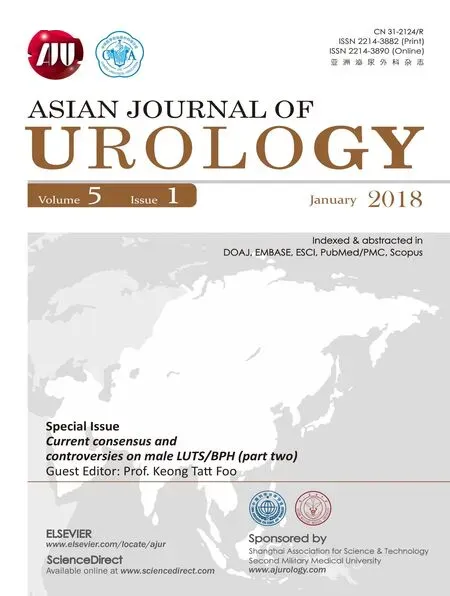Current consensus and controversies on male LUTS/BPH(part two)
Part one of this special issue dealt with the historical development,epidemiology,aetiology and pathophysiology of clinical benign prostatic hyperplasia(BPH).With the current definition that clinical BPH is prostate adenoma/adenomata(PA)causing a varying degree of obstruction irrespective of symptoms,the disease can be diagnosed with transabdominal ultrasound in the clinic with confidence and managed accordingly.This definition of clinical BPH would help explain some of the puzzles in lower urinary tract symptoms(LUTS)/BPH,such as why small prostates can cause significant obstruction while big prostates may not have obstruction[1].
Part two of this issue focuses on the differential diagnosis of underactive bladder as a cause of male LUTS and poor uro flow[2].Various ways of assessing patients with male LUTS/BPH with non-invasive ultrasound-measuring bladder wall thickness,estimated bladder weight,intravesical prostatic protrusion(IPP)and resistive index-are also reviewed[3].IPP still stands out as the most promising method as it is the cause of clinical BPH and the degree of IPP is related to benign prostatic obstruction(BPO)and therefore progression of the disease.
Alpha blockers do not prevent progression.Only the 5-alpha reductase inhibitors(5ARIs)have been proven to be useful in preventing progression and reducing the size of the PA[4].But while 5ARIs can reduce the size of the PA,they do not correct the shape and thus some patients may still not respond to the medical treatment.Currently there are many minimally invasive methods available for clinical BPH treatment apart from surgery.The use of Botox injection remains controversial,but it may have a role in the management of small PA[5].Prostate urethral lift has shown good results but long-term follow-up for further assessment is needed.Many other devices are still investigational.Of these,aqua-ablation with high pressure water jet appears to be promising[6].
For patients with severe BPO affecting the voiding function(persistently high postvoid residual urine more than 100 mL)or those with storage dysfunctions(frequency and urgency and low maximum voided volume),surgery for the obstructing PA would be indicated.
Transurethral resection of prostate(TURP)has been the gold standard for surgical treat ment of BPH for the past many decades.However,with better understanding of the pathophysiology of BPH,that it is essentially localized PA with irregular shape and size,the way forward would be the enucleation of the offending pathology.Conventional TURP or laser vaporisation often leaves residual PA that can give rise to recurrent growth of the PA many years later.These patients often present with painless gross hematuria,recurrent LUTS,elevated PSA or retention of urine.To overcome the problem of recurrent adenoma,transurethral enucleation procedures would be the surgical treatment of choice.
The bipolar enucleation technique by Xu et al.[7]and the use of the vaportrobe(Xie’s technique)[8]may be cost effective methods in the developing countries of Asia.These two techniques are described and their results reviewed in this issue.It is interesting to note that voiding function and sexual function may improve with restoration of normal anatomy by total enucleation,as postulated by Xu et al.[7].Enucleating only the PA and preserving the bladder neck and normal prostate tissue may allow the patient to retain normal ejaculation,a hypothesis that requires validation with further studies.With giant-sized prostates,enucleation can still be done with less blood loss.For those centres with expertise in laparoscopic technique,laparoscopic simple prostatectomy may have a place[9].
Finally,I would like to thank all the authors for their excellent contributions and reviewers behind the scene for their invaluable comments to improve the manuscripts.
[1]Thomas D,Chughtai B,Kaplan S.Commentary on“Solving the benign prostatic hyperplasia puzzle”.Asian J Urol 2018;1:10-1.
[2]Aldamanhori R,Osman NI,Chapple CR.Underactive bladder:Pathophysiology and clinical significance.Asian J Urol 2018;1:17-21.
[3]Mangat R,Ho HSS,Kuo TLC.Non-invasive evaluation of lower urinary tract symptoms(LUTS)in men.Asian J Urol 2018;1:42-7.
[4]Kim EH,Brockman JA,Andriole GL.The use of 5-alpha reductase inhibitors in the treatment of benign prostatic hyperplasia.Asian J Urol 2018;1:28-32.
[5]Ng LG.Botulinum toxin and benign prostatic hyperplasia.Asian J Urol 2018;1:33-6.
[6]Chung ASJ,Woo HH.Update on minimally invasive surgery and benign prostatic hyperplasia.Asian J Urol 2018;1:22-7.
[7]Xu P,Xu A,Chen B,Zheng S,Xu Y,Li H,et al.Bipolar transurethral enucleation and resection of the prostate:Whether it is ready to supersede TURP?Asian J Urol 2018;1:48-54.
[8]Xie L,Wang X,Chen H,Zheng X,Liu B,Li S,et al.Innovative endoscopic enucleations of the prostate-Xie’s Prostate enculeations.Asian J Urol 2018;1:12-6.
[9]Manickam R,Nachimuthu S,Kallappan S,Pai MG.Laparoscopic adenectomy in BPH-Does it have a role today?Asian J Urol 2018;1:37-41.
 Asian Journal of Urology2018年1期
Asian Journal of Urology2018年1期
- Asian Journal of Urology的其它文章
- Obituary for Donald S.Coffey:Remembering a pioneer in the field of prostate cancer research.(1932-2017)
- Updates in prostate cancer detections and treatments-Messages from 2017 EAU and AUA☆
- Commentary on“Solving the benign prostatic hyperplasia puzzle”
- Underactive bladder:Pathophysiology and clinical significance
- Update on minimally invasive surgery and benign prostatic hyperplasia
- The use of 5-alpha reductase inhibitors in the treatment of benign prostatic hyperplasia
